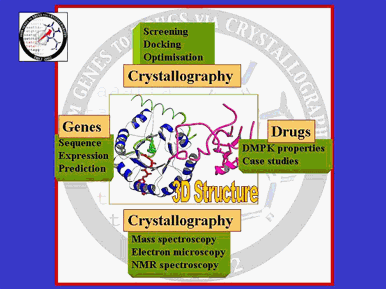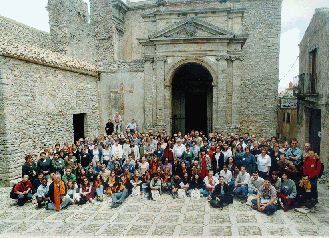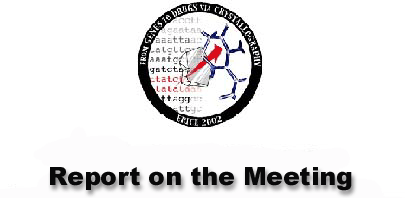 This
was the fourth Course in the series of structure based drug design at Erice
(previous Courses were held in 1983, 1989 and 1996). The scientific plan
was to scrutinise all aspects related to structural research, from the coding
sequences to proteins and the analyses of protein-ligand complexes leading
to the design of new drugs.
This
was the fourth Course in the series of structure based drug design at Erice
(previous Courses were held in 1983, 1989 and 1996). The scientific plan
was to scrutinise all aspects related to structural research, from the coding
sequences to proteins and the analyses of protein-ligand complexes leading
to the design of new drugs.
Twenty years have elapsed since the NATO Scientific Committee rejected
the application for funding the first Meeting of this series entitled "X-ray
Crystallography and Drug Action", on the grounds that "the two
fields fall too far apart" !!!!
In this time, genome sequencing initiatives have provided a plethora of
information which hold considerable promise for drug discovery and development.
The most promising advances in drug discovery and development were highlighted
in the contributions by Baker and Blundell. The maximal exploitation of
genomic data for therapeutic purposes lies in accurately identifying the
biological function of the protein coded by a given gene, as illustrated
in the lectures by Rost, Shokat and Vriend. Approaches towards the goal
of predicting the form of proteins and investigate the interdependence of
structure and function were discussed by Sippl and Thornton.
Interdisciplinary methodologies to study macromolecular structures were
extensively illustrated by Markley (NMR), Stark (Electron Cryomicroscopy),
Liu (Mass Spectrometry), Klebe (Energetics), Shoichet (High Throughput Screening).
The current status of macromolecular crystallography was discussed in a
special session dedicated to the advances in revealing the ribosome structure
(Ban, Ramakrishnan, Yonath) and the related research on ribosome-antibiotics
interactions
.
Technological advances of the established crystallographic procedures (Hauptman
and Glusker) are at a stage where assessment, understanding and exploitation
of ligand-protein interactions revealed by the X-ray structures of target
proteins and their complexes (Fitzgerald, Mikol, Rossmann) have become an
obligatory and essential component of the drug discovery process.
Since the Meeting covered a wide range of disciplines of interest to both academia and industry, several workshops, tutorials and poster sessions were scheduled into the program so as to provide practical forums for scientific exchange. In order to encourage young researchers , the plenary lectures by distinguished invited speakers were integrated with brief oral presentations by selected scientists relatively new to the field, expanding on the message in their Posters. In all, over 100 selected participants (out of 262 applicants) from 33 nations were addressed by 26 invited speakers The hands-on sessions (for which 12 PCs and 6 graphic stations have been rented) received some criticism, mainly related to local conditioning of space and time: however, the facilities for running multiple sessions overseen with dedication and perseverance by John Irwin, Northwestern University, Chicago have called for much praise.
The Director strongly encouraged participation in the Flow-Chart competition. All participants were divided into nine groups, with the remit of constructing a Flow-Chart which would illustrate the title of the Meeting. This competition was very well received and has represented a colourful way of capturing the essence of the steps involved in proceeding from structural genomics to the synthesis of candidate drugs, as well as providing an effective route to social and multi-disciplinary scientific dialogue between novices and experts. The success of the Meeting is best expressed in terms of the excellent average score of 88 received in answer to the question "How do you score (0-100, 100 maximum) the overall value of the meeting to you" posed in an anonymous questionnaire to the participants at the close of the Meeting.
This meeting was the third event of a EuroSummerSchools series (HLSC-CT 1999-00006), European Commission, DG Research, Bruxelles, and was sponsored and supported by the International Union of Crystallography and the International Union of Biochemistry and Molecular Biology. The INCO Programme, EC, Bruxelles, allowed a substantial funding towards travel and subsistence for fourteen participants from Eastern European countries
The Course benefited greatly from a large financial support received from Hoffmann LaRoche; Inpharmatica, London; Janssen Pharmaceutica, Beerse; Merck & Co, Inc., USA; Novartis, Basel. An additional number of companies, AkzoNobel Organon, The Netherlands; AstraZeneca, Sweden & UK; Bruker-axs, Germany; CellTech R&D Ltd., UK; Elsevier "Current Opinion in Structural Biology", London; Hampton Research Corp., Laguna Niguel, CA; Merck KgaA, Germany; Novo Nordisk, Bagsvaerd, DK; Pfizer, UK; Pharmacia Italia, Nerviano, Milan; Schering Plough, Kenilworth, NJ have agreed to contribute financially to the organization of the meeting.

Click on the photo for a decent enlargement
With the help of Antonio Cavallaro, a student in Communication Sciences, University of Bologna, we plan to enable web navigators to download the scientific contributions and records of social events.

